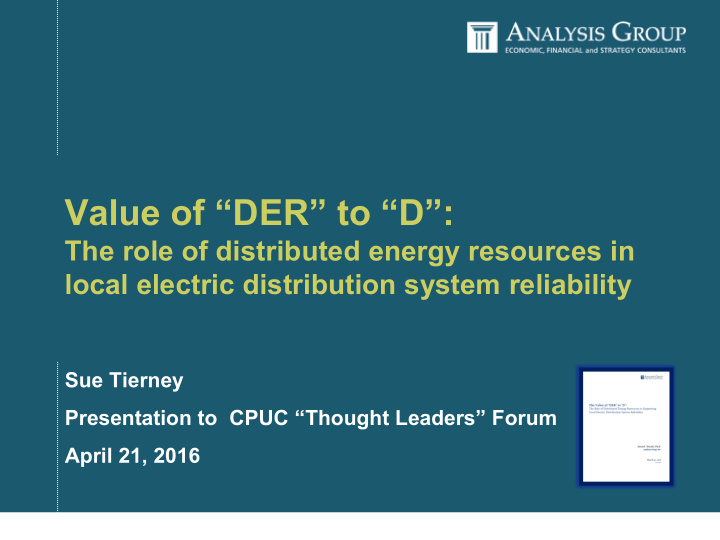



Value of “DER” to “D”: The role of distributed energy resources in local electric distribution system reliability Sue Tierney Presentation to CPUC “Thought Leaders” Forum April 21, 2016
Context: Multiple Lenses on the Value of DERs: Value to whom and for what? Retail Electric Electricity Distribution Customer Utility with DERs Utility-Scale Society: Power External Supply and Impacts Transmission The focus of this discussion (and Tierney white paper) April 2016 Page 2
Core questions to regulators relating to DERs for D: How to think about the value of DER to the distribution system (“The Value of DER to D”)? In light of differences among DERs’ characteristics In light of differences across utility system configurations Given interactions of DERs and the local distribution system, what are implications for the following? Distribution-system planning DER procurements Compensation to DER providers April 2016 Page 3
Key findings Different DER technologies have different attributes and different impacts on / contributions to the electric system The value of DERs to D depends on: Their location on the distribution grid Their having attributes that provide the needed characteristics of availability, dependability, and durability (sustainable supply) Most potentially avoidable distribution-related costs are tied to deferred capital investments Studies indicate the Value of DER to D is typically small relative to the Value of DER to Generation (G), Transmission (T), or Society (S) April 2016 Page 4
Case studies: Two distribution utilities engaged EPRI to analyze the goodness-of-fit of DERs to cost-effectively defer traditional distribution investment April 2016 Page 5
Case studies: These utilities’ distribution systems are very different Its Radial Distribution System Resembles a Tree Its Network Distribution System Resembles a Mesh Customers are Served Off of the System’s Branches Customers are Served Off of Interconnected Wires April 2016 Page 6
Case studies: EPRI’s preliminary results Individual DERs (and portfolios of different DERs) have different and complex interactions with the electric system. To effectively defer/replace traditional distribution solutions, DERs need to have equivalent availability, dependability and durability. DER impacts can be either beneficial or adverse, depending on a wide variety of contextual circumstances. This makes it difficult to generalize. April 2016 Page 7
Insights: Integrating DERs into distribution planning Utilities should integrate DERs into distribution planning to consider the potential for DERs to substitute for traditional utility investments Integrating DERs into local reliability planning and operations allows the opportunity for cost-effective local reliability solutions Planning with DERs needs to fit within the long lead times for most traditional fixes . April 2016 Page 8
Insights: Evolve compensation for DERs to D to be more value-based Current benefit/cost frameworks are only the beginning of the process of determining whether DERs are net beneficial New methods for valuing DERs for D should be built on the timeless regulatory principles so as to create value for all customers on the local systems. Efficiency & fairness principles should be core to efforts attempting to create value for all customers on the distribution system. April 2016 Page 9
Insights: Lessons from PURPA can inform the evolution Prior PURPA experience teaches that market-based mechanisms led to greater value to customers: Early PURPA implementation (with standard offers, administratively determined prices ) helped start the small-power-producer market, but with later costs associated with above-market contracts Subsequent PURPA implementation evolved to competitive solicitations to reveal the portfolio of contracts consistent with the utility’s needs and at market-based prices April 2016 Page 10
Insights: Competition will create value to consumers April 2016 Page 11
Conclusions: Insights for further consideration of the Value of DERs to D Rely on time-tested ratemaking principles of efficiency and fairness Pay attention to the differences among DER technologies and their contributions to the local grid in calculating their potential value to D Transition distribution-system planning to incorporate DERs Move beyond conceptual benefit/cost frameworks that identify potential net benefits of DERs to D, to payment structures that take advantage of competition April 2016 Page 12
Conclusions: Insights for further consideration of the Value of DERs to D Recognize that there may be a misalignment between funding for DERs’ based on their full value (to distribution, generation, transmission, society), and the portion of value attached to D Build upon PURPA experience that market-based mechanisms provide value to customers compared to administratively determined avoided costs Start with forward contracting for DER capacity before focusing on operational/transactional DER markets Affirmatively address financial incentives to utilities and missing money issues Consider pilots as a good way to test out new concepts April 2016 Page 13
Thank you Energy Produced from the Solar PV Panels on Tierney Roof In 15-minute Intervals (kWh) During All Hours in a 7-day period (Sunday-Saturday) in July 2015 Sue Tierney Senior Advisor Analysis Group April 2016 Page 14
Recommend
More recommend